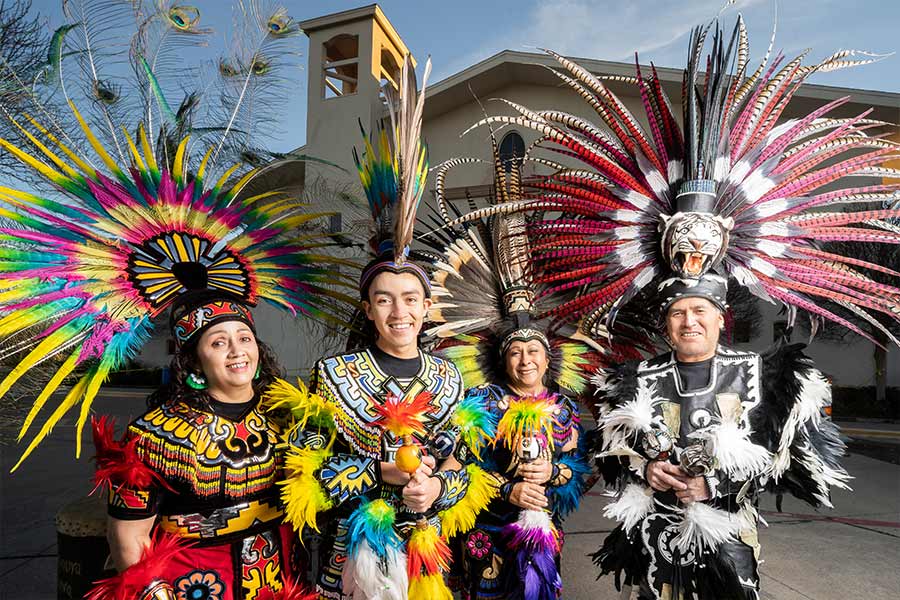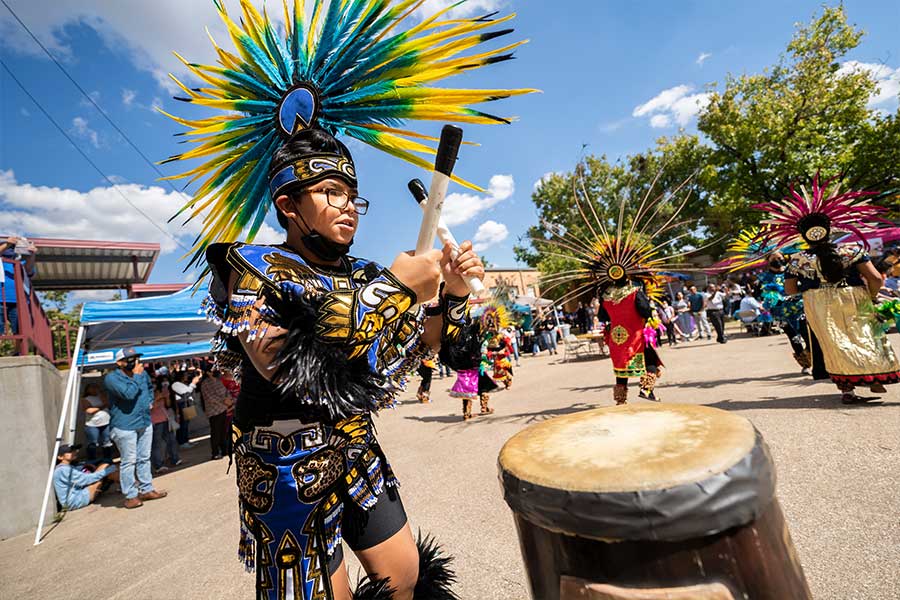Dance lessons: Danza Azteca invites everyone to come closer to Jesus

Rosaura Nava de Alanís, Diego Alanís, Claudia Patlán, and Ismael Patlán at Holy Name of Jesus Parish in Fort Worth. (NTC/Juan Guajardo)
Diego Alanís, 15, affirms that entering the church, dancing in honor of Our Lady of Guadalupe, to the rhythm of strong drumbeats and the vibrant sound of the conch, proudly dressed in his long-feathered headdress, a colorful pectoral, and ankle bones, reflects his faith.
At that moment, “I feel there is only God and me, and I offer Him what I can give Him, which is my dance,” Alanís said, adding that he expresses his love for God and the Virgin of Guadalupe through Aztec dance.
Alanís is part of Danza Azteca at Holy Name of Jesus Parish in Fort Worth, formed three years ago. It currently has 25 members between 12 and 60.
Aztec dance’s movements include big jumps, fast turns, and constant crouching, which require good physical condition. The troupe rehearses twice weekly, beginning at the end of February, to be ready for the Feast of Our Lady of Guadalupe on December 12. They also participate in parish activities, including praying the Holy Rosary, to promote spiritual growth. The group’s mission is “to bring parishioners closer to faith,” said Juan Matías, 32, a founder of Danza Azteca and a parishioner of Holy Name for five years.
Dancing is not exercising or merely a show, “but a joy that is offered to God,” said Matías, an Aztec dancer since he was 16 in his native Mexico City. He calls it a “blessing” to share his experience and teach the traditional Aztec dance.
“It started as a dream because there was no Danza Azteca group in the Fort Worth area,” he said. “Thank God, they gave us permission to rehearse in the parish.” Matías recalled only four members attended the first rehearsals.
“As Catholics, we don’t want people to think other gods are praised in these dances,” Matías pointed out. “On the contrary, it means remembering the apparitions of the Virgin of Guadalupe on the Tepeyac Hill, after the fall of the Aztec Empire [and the] Spanish conquest, and her beautiful image embodied in San Juan Diego’s cloak. Thanks to the Virgen Morena, a large number of indigenous converted to the Catholic faith and began to venerate her with dances,” explained Matías, who affirmed the ministry’s commitment to participate only in religious events.
After each “Guadalupian gala,” the colorful costumes, handmade in Mexico, must be steam washed. The multiple feathers on each headdress, up to three feet long, are disassembled for cleaning. The six drums and eight conches are retouched with paint to keep them in good condition.
Entrusting themselves to God and the Virgin Mary, Matías pointed out, has borne numerous fruits, such as leading a Rosary every Sunday before 10 a.m. Mass, invitations to dance at other parishes, seeing families dance together, and the joy of watching some members enter RCIA and return to the Catholic faith.
Rosaura Nava, a Mexico City native, said, “It is a great joy to have my children dance with me and see them excited to dance to the Virgin and to be close to God,” she said about her son, Diego Alanís, and her eldest son, who also danced before going to college.
Nava, who helps coordinate the group, highlighted the enthusiasm of the dozen young dancers and hopes they “follow the legacy” of Aztec dance “and use that energy to live their faith and get fully involved in parish life.”

Joshua Hernandez plays the drums with Danza Azteca at the St. Rita International Fair on Oct. 3, 2021. (NTC/Juan Guajardo)
Diego not only celebrates “sharing my faith with more people my age” but also appreciates the example of the adult dancers. He does not want to stop “until I do what I set out to do, because all this is to provide glory to the one God,” he added.
Dancing brings Rosaura fond memories of her childhood when she went to visit the Basilica of Guadalupe with her mother and “saw the fervor of the dancers who came to see the Virgin.” Every time she enters her parish with that same dress she saw as a child, she feels she is bringing to her parish “a little bit of Mexico so that they feel like a family, and celebrate our Mother, the Virgin of Guadalupe, who leads us to her beloved son, Jesus Christ.”
Ismael Patlán, one of the first four members of Danza Azteca, said, “I had never danced before. We learned the moves and, little by little, we saw a tremendous change. Moved by the desire to dance to the Virgencita, we have seen that it is possible to move forward as a family.”
“When one is moved and directed by faith, there is a greater dedication and immense joy,” said Claudia Patlán, Ismael’s wife, who joined the dance after seeing her husband rehearse.
In addition to Danza Azteca, the Patlán couple participates in other ministries — as do most group members — who serve as lectors, altar servers, ushers, and with the youth group.
“By getting involved in a ministry, you get to know your parish community, and you are aware that your service is for God; that is why you give the best of yourself,” Claudia asserted.
She recognizes that although the physical effort for the dance requires a lot of practice, what’s most important is spiritual growth. “Not only do we recite the Holy Rosary and the Chaplet of Divine Mercy in church, but we also pray at the beginning of each rehearsal. That has helped the group to remain true to their dedication and continue to grow,” she added.
- - -
Symbolism in Aztec Dance
Feathers on the headdress: Dancers emulate a bird flying in the sky by hopping, crouching, and spinning fast. They represent the birds that sang when Our Lady of Guadalupe appeared on the Tepeyac Hill.
Drum: Made from a single piece of tree, it is solid, like the rock that is our God.
Conch: Its sound symbolizes the water that falls from the sky. God sends the rain, which reaches the sea; the lakes and rivers are filled, where the conch lives.
